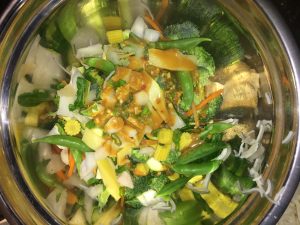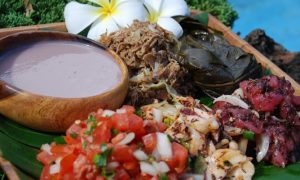 My first foray with Hawaiian food was from a little hole in the wall Hawaiian Diner while on a road trip. What stuck with me was the diversity of the food present on the table. It clearly had both Polynesians, Asian, and Caribbean roots. What interest me is culture and ethnic groups as immigrants come together and influence each other’s foods. Hawaii is the perfect case for this with it’s isolated geography and clear waves of immigrants from a diverse origins. Looking at how what we know today as “Local Food” (combination of different ethnic groups) and “Native Foods” (original Hawaiian) of the islands is a case of an amalgamation of cultures into a new fusion cuisine that is unique to Hawaii.
My first foray with Hawaiian food was from a little hole in the wall Hawaiian Diner while on a road trip. What stuck with me was the diversity of the food present on the table. It clearly had both Polynesians, Asian, and Caribbean roots. What interest me is culture and ethnic groups as immigrants come together and influence each other’s foods. Hawaii is the perfect case for this with it’s isolated geography and clear waves of immigrants from a diverse origins. Looking at how what we know today as “Local Food” (combination of different ethnic groups) and “Native Foods” (original Hawaiian) of the islands is a case of an amalgamation of cultures into a new fusion cuisine that is unique to Hawaii.
History + Recipes: The Food of Paradise : Exploring Hawaii’s Culinary Heritage *Best Read
The Food of Paradise is both a cookbook and an anthropological text. It is divided into multiple parts first with Native Hawaiian foods, and then going into the different ethnic groups that contributed to modern Hawaiian cooking. The author converted on local food and the history and cultural significance behind it. As a whole this book is both a cookbook, a history book, and an ethnic studies book rolled into one. The author wrote this book for anyone and included explanation of local terms for those unfamiliar with the area.
Stories behind the Food: Family Ingredients on PBS | Hawai’i – Poi. *most interesting video
The show Family Indigents is on PBS and is hosted and produced by Ed Kenney. He is a chef and lover of food. His philosophy of food bring people and family together is what started the series. This is the first episode; where explores his family and roots in Hawaii. His mother is a native Hawaiian and he grew up on the islands. In this episode he explores the Hawaiian food poi and the ingredient of taro the plant that makes the food. The audience is foodies and people who think of food as a way to bring people together and look at their roots. It is published on PBS online as a video where anyone can watch it for free and was broadcasted along PBS stations on the West Coast and Hawaii. To me this is an interesting document because he explains the food and the ingredients within the context of his own family upbringing and in a native Hawaiians context. He analyzed how taro has changed over the years and how the state of poi in current day Hawaii. He touches on the changing Hawaiian diet that is mentioned in other texts. I would put this text into the genre of videos and TV docuseries. In the series he explores different places through the lens of family foods. It is important to note that this series is produced and hosted by a Hawaiian and the other executive producers are female so there is no gender bias.
History + Recipes: Hawaiian Food: A History and Recipes | In Football We Trust
This article was written for PBS by a Hawaiian man and his wife. Both describe themselves as lovers of land. The piece looks to explain the history of Hawaiian food and food from Hawaii. It tells the story of the original Hawaiian foods and the current amalgamation of cultures on the island that makes what we think of as Hawaiian food today. It describes the Hawaiian peoples and all those that immigrated theirs reliance and new fold love of each other’s foods. The writer is a native Hawaiian who is a trained chef from the Culinary Institute of the Pacific and the Culinary Institute of America. Both he and his wife are community leaders in revitalizing the Hawaiian food scene both locally and internationally. The author wrote this as an education piece on how Hawaiian food has evolved to what they see today at football parties. The audience is anyone with even a remote interest in Hawaiian food and the author includes multiple recipes that are easy to follow. This is an opinion editorial along with a history of the Hawaiian food culture. The text is interesting because it explain how we we know as Hawaiian food came to be and how it is constantly changing and evolving. This is both a collection of recipes and a celebration of the unique culture.
Health of Hawaiians: The Integral Role of Food in Native Hawaiian Migrants’ Perceptions of Health and Well-Being.” Journal of Transcultural Nursing 22 *for the Health Science inclined
This is a study from the Journal of Transcultural Nursing looking at the obesity among Native Hawaiians who move to the continental US along with the obesity among Native Hawaiians in Hawaii. Obesity is highly prevalent among both groups but more so among those who move to the continental US. The study was to look at the relationship between food, perception of health and well being. It was common that after moving to use food as a way to alive homesickness except here the food was less expensive and in larger portions leading to weight gain. Overall it advises healthcare professionals to be more casual with Hawaiians by talking about family first before advising on health care. It also advised a diet plan that would help alive homesickness with the healthy native foods along with exercises such as Hula and canoeing that would bring them to the cultural roots without weight gain. The study was conned by a white female who has no connection to Hawaii but she had her research students be of Hawaiian ethnicity and worked with them for cultural sensitivity and did sensitivity training throughout the course of the study. The audience is others in the healthcare profession who are dealing with a Hawaiian population that is obese and had health care problems that go along with obesity. This is a scientific journal and is advocating for change in both how Hawaiians eat and deal with homesickness and how health care professionals treat them.
Vocab and History: The Food In Hawaii Is Not Necessarily Hawaiian — Cooking In America. *easy to watch
This video is hosted by a Hawaiian native who was on Top Chef. In the video he explains the difference from local food and native Hawaiian food and the story behind how it came to be along with making food. It’s part history lesson and part food blog. It is meant for anyone interested in Hawaiian food at a basic level. The video is interesting because it explores this idea from the lense of a native Hawaiian.
Review: Regional Powerhouse Chains: L&L Hawaiian Barbecue.
This is a restaurant review for the L&L Hawaiian Barbecue chain and looks at how they came to prominence. Overall L&L is what many Hawaiians are familiar with at home; a dinner that serves different kinds of plate lunches. A plate lunch is two large scoops of rice, a scoop of macaroni salad, and a centre of meet; if there are multiple proteins it is called a mixed plate. This is something that can be found almost everywhere in Hawaiian with different groups having different proteins with Korean, Japanese, Chinese, and Hawaiian proteins found on the menu. This coupled with Hawaiian barbecue, managers, and simian noodles other staples of the island and its multiethnic population makes for a powerhouse of chain restaurants. This review was written for foodies and those looking at restaurants. The review is not from Hawaii but does know about local trains. It is interesting to look at how the Hawaiian chain started there and upon coming stateside exploded and is incredibly profitable and has a cult following among Hawaiian who moved stateside and normal Americans alike due to its great food, large quantity, and cheap prices.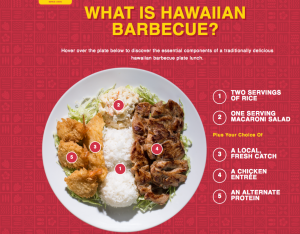
Menu and About: L&L Hawaiian Barbecue
This is the L&L Hawaiian Barbecue chain’s website. It is pulled up to the about page and I would also recommend going to the menu page. It has clear pictures of what each item is along with explaining what a plate lunch is to both the Hawaiian culture and to those wanted to order it. When you click on the picture a description will pop up along with the nutrition information for that item. . On the menu is mainly plate lunch style with assorted proteins of different cultures that have become part of the Hawaiian culture. An example of this is this is Chicken Katsu (Japanese) or BBQ Ribs (Korea), Loco Moco (burgers with egg on top) or BBQ Chicken (Southern style). This coupled with the spam options of Spam Musubi (spam sushi), Spam Saimin (noodle soup). The website is meant for a customer from any background and is viable for any customer over the internet. The text is interesting in that it bridges the gap between Hawaiian dinner food via plate lunch and American food. Ready for the average American consumer to try.
Menu and About: Poke-Poke *tried and tested highly recommended for those near
This is the website for a local Poke restaurant in Austin TX. It is the second restaurant with the first in Venice beach. The menu is more true to the ‘healthy’ aspect of Hawaiian food. It only consists of different raw fish pokes, with rice options available, along with acai bowls. Acai bowl while not being Hawaiian have become part of the surfing culture with its origins in Brazil. In the late 1980’s and mid 1990’s it made its way to both Hawaii and California through the surfing culture and only recently has come to Austin. The menu has only raw fish, tofu, and vegetarian options and is built with the health consciousness in mind. The restaurant is the brainchild of a native Hawaiian and his wife. It has more of a mom and pop feel rather than a chipotle style assembly line like other poke shops that are hopping on the trend.
Mainstreaming Poke: The Splendid Table: Martha Cheng: Poke’s Simplicity Invites Improvisation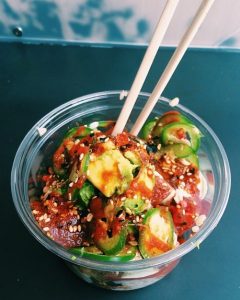
This is a part of the splendid table podcast; this section focuses on poke Martha Cheng who is being interviewed is a Hawaii local and author of The Poke Cookbook. In this interview she explain that poke as we know it is a relatively new Hawaiian food made in the 1970s. The original word of poke was made by native Hawaiians with raw fish, salt, and some seaweed; however the poke we think of today was made by the kids and grandkids of plantation workers of Japanese and Chinese descent. Oil and shoyu were added and is served everywhere. From gas stations, Costco, to beers with friends after work poke is as common as chips and salsa on the content. The audience for this podcast is anyone who enjoys food and the authors are Martha Cheng who is interviews and the Sally Swift one of the personalities on the Splendid Table podcast series. This text is interesting because it shows how influence little things are to the Hawaiian palate and food culture. Where something never heard of has exploded on the island and even stateside so fast.
Government Takes Notice: Creation of Hawaiian Food Week: Congress Document
This document is from the United States senate; last year through Senator Rounds the creation of Hawaiian Food Week was passed. This was the first time the US had officially recognized that Hawaii has contributed to the culinary heritage of the country. The history is linked with foods brought by native Hawaiians and the next groups of voyagers, the land and ranching ability of the island, and the amazing seafood that is offered by the island. It was celebrated as an ideal mixing of cultures and ethnicities through the food of Polynesia, China, Japan, Korea, among other island nations. The food is what bonded together the immigrants and created the uniquely Hawaiian spirit of sharing food and being familiar and friendly with neighbors. It celebrates Hawaiian food and helps memorialize it into the American conscious .
 My first foray with Hawaiian food was from a little hole in the wall Hawaiian Diner while on a road trip. What stuck with me was the diversity of the food present on the table. It clearly had both Polynesians, Asian, and Caribbean roots. What interest me is culture and ethnic groups as immigrants come together and influence each other’s foods. Hawaii is the perfect case for this with it’s isolated geography and clear waves of immigrants from a diverse origins. Looking at how what we know today as “Local Food” (combination of different ethnic groups) and “Native Foods” (original Hawaiian) of the islands is a case of an amalgamation of cultures into a new fusion cuisine that is unique to Hawaii.
My first foray with Hawaiian food was from a little hole in the wall Hawaiian Diner while on a road trip. What stuck with me was the diversity of the food present on the table. It clearly had both Polynesians, Asian, and Caribbean roots. What interest me is culture and ethnic groups as immigrants come together and influence each other’s foods. Hawaii is the perfect case for this with it’s isolated geography and clear waves of immigrants from a diverse origins. Looking at how what we know today as “Local Food” (combination of different ethnic groups) and “Native Foods” (original Hawaiian) of the islands is a case of an amalgamation of cultures into a new fusion cuisine that is unique to Hawaii.


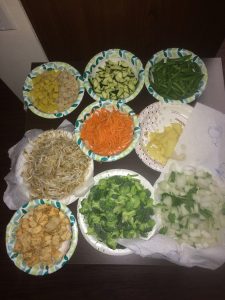 ell, place in a large bowl, and chill.
ell, place in a large bowl, and chill.